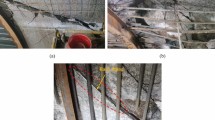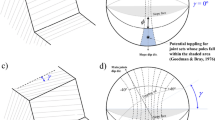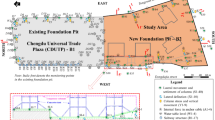Abstract
The south slope of the Fushun west open-pit mine in China is geologically complex and is a high-steep rock slope. In recent years, a larger deformation has appeared in the south slope, with the gradual formation of a potential landsliding block that is estimated to be over 300 m3. The east and south boundaries of the block have been identified using different monitoring techniques. However the west boundary has not yet been clearly delineated, a situation which undermines safety assessments and the slope management of the mine. The focus of this was on how the microseismic technology, DInSAR technique and the numerical method are used to determine the shape and formation of the west boundary of the potential sliding block. We found that the upper part of west boundary as determined by numerical simulation is concordant with that determined by microseismic monitoring. The surface deformation area coincides with the DInSAR monitoring results and damage area based on in situ observations. Numerical simulation provides supplementary information on the distribution of stress and the formation process of the west boundary that cannot be observed directly on-site. The microseismic monitoring system was able to capture the progressive rupture of the west boundary during the deformation of the block. The cooperative monitoring strategy together with the numerical simulation can delineate the sliding surface and provide a method for a comprehensive assessment of the slope stability of other similar open-pit mines.




















Similar content being viewed by others
References
Akbar TA, Ha SR (2011) Landslide hazard zoning along Himalayan Kaghan Valley of Pakistan—by integration of GPS, GIS, and remote sensing technology. Landslides 8(4):527–540
Bozzano F, Cipriani I, Mazzanti P et al (2011) Displacement patterns of a landslide affected by human activities: insights from ground-based InSAR monitoring. Nat Hazards 59(3):1377–1396
Brown N, Kaloustians Roeckle M (2007) Monitoring of open pit mines using combined GNSS satellite receivers and robotic total stations. In: Proc Int Symp Rock Slope Stability in Open Pit Mining and Civil Engineering. Australian Centre for Geomechanics, Perth, pp 417–429
Bürgmann R, Rosen PA, Fielding EJ (2000) Synthetic aperture radar interferometry to measure Earth’s surface topography and its deformation. Annu Rev Earth Planet Sci 28(1):169–209
Casagli N, Catani F, Del Ventisette C et al (2010) Monitoring, prediction, and early warning using ground-based radar interferometry. Landslides 7(3):291–301
CCTEG Shenyang Research Institute (2013) Investigation on the stability of south slope of Fushun west open mine. CCTEG Shenyang Research Institute, Fushun. (in Chinese)
Colesanti C, Wasowski J (2006) Investigating landslides with space-borne synthetic aperture radar (SAR) interferometry. Eng Geol 88(3):173–199
Di Traglia F, Intrieri E, Nolesini T et al (2014) The ground-based InSAR monitoring system at Stromboli Volcano: linking changes in displacement rate and intensity of persistent volcanic activity. Bull Volcanol 76(2):786. https://doi.org/10.1007/s00445-013-0786-2
Fang Z, Harrison JP (2002) Development of a local degradation approach to the modelling of brittle fracture in heterogeneous rocks. Int J Rock Mech Min Sci 39(4):443–457
Fernández J, Yu TT, Rodrıguez-Velasco G et al (2003) New geodetic monitoring system in the volcanic island of Tenerife, canaries, Spain. Combination of InSAR and GPS techniques. J Volcanol Geotherm Res 124(3):241–253
Feng GL, Feng XT, Chen B et al (2015) A microseismic method for dynamic warning of rockburst development processes in tunnels. Rock Mech Rock Eng 48(5):2061–2076
Fraser CS, Edmundson KL (2000) Design and implementation of a computational processing system for off-line digital close-range photogrammetry. ISPRS J Photogramm Remote Sens 55(2):94–104
Gabriel AK, Goldstein RM, Zebker HA (1989) Mapping small elevation changes over large areas: differential radar interferometry. J Geophys Res Solid Earth 94(B7):9183–9191
Ge L, Rizos C, Han S et al (2001) Mining subsidence monitoring using the combined InSAR and GPS approach. In: Proc 10th Int Symp Deformation Measurements. Orange, CA, pp 1–10
Ge M (2005) Efficient mine microseismic monitoring. Int J Coal Geol 64(1):44–56
Herrera G, Tomás R, Vicente F et al (2010) Mapping ground movements in open pit mining areas using differential SAR interferometry. Int J Rock Mech Min Sci 47(7):1114–1125
Hu X, Zhang M, Sun M et al (2015) Deformation characteristics and failure mode of the Zhujiadian landslide in the three gorges reservoir, China. Bull Eng Geol Environ 74(1):1–12
Huang Q, Jia-lin W, Jian-hui D (2009) Slope deformation character analysis based on monitoring results of multiple multi-point borehole extensometer. Chin J Rock Mech Eng 28:2667–2673 (in Chinese)
Jarosz A, Wanke D (2003) Use of InSAR for monitoring of mining deformations. In: Proc FRINGE 2003 Workshop. Frascati, Italy, pp 1–5
Kimura H, Yamaguchi Y (2000) Detection of landslide areas using satellite radar interferometry. Photogramm Eng Remote Sens 66(3):337–344
Li LC, Tang CA, Li CW et al (2006) Slope stability analysis by SRM-based rock failure process analysis (RFPA). Geomech Geoeng 1(1):51–62
Li LC, Tang CA, Zhu WC et al (2009) Numerical analysis of slope stability based on the gravity increase method. Comput Geotech 36(7):1246–1258
Li SJ, Feng XT, Li ZH et al (2011) In situ experiments on width and evolution characteristics of excavation damaged zone in deeply buried tunnels. SCIENCE CHINA Technol Sci 54:167–174
Liang ZZ, Xing H, Wang SY et al (2012) A three-dimensional numerical investigation of the fracture of rock specimens containing a pre-existing surface flaw. Comput Geotech 45:19–33
Little MJ (2006) Slope monitoring strategy at PPRust open pit operation. In: Proc Int Symp Stability of Rock Slopes in Open Pit Mining and Civil Engineering. Johannesburg South Afr Inst Min Metall 2006:211–230
Lynch R A, Wuite R, Smith BS et al (2005) Microseismic monitoring of open pit slopes In: Potvin Y, Hudyma M (eds) Proc 6th Symp Rockbursts and seismicity in Mines. Australian Center for Geomechanics, Perth, pp 581–592
Ma GW, Wang XJ, Ren F (2011) Numerical simulation of compressive failure of heterogeneous rock-like materials using SPH method. Int J Rock Mech Min Sci 48(3):353–363
Ma K, Tang CA, Wang LX et al (2016) Stability analysis of underground oil storage caverns by an integrated numerical and microseismic monitoring approach. Tunn Undergr Space Technol 54:81–91
Ma TH, Tang CA, Tang LX et al (2015) Rockburst characteristics and microseismic monitoring of deep-buried tunnels for Jinping II Hydropower Station. Tunn Undergr Space Technol 49:345–368
Massonnet D, Rossi M, Carmona C et al (1993) The displacement field of the landers earthquake mapped by radar interferometry. Nature 364(6433):138–142
Mendecki AJ (1996) Seismic monitoring in mines. Springer Science & Business Media, Berlin Heidelberg New York
Pearce CJ, Thavalingam A, Liao Z et al (2000) Computational aspects of the discontinuous deformation analysis framework for modelling concrete fracture. Eng Fract Mech 65(2):283–298
Pérez OJ, Sanz C, Lagos G (1997) Microseismicity, tectonics and seismic potential in southern Caribbean and northern Venezuela. J Seismol 1(1):15–28
Peyret M, Djamour Y, Rizza M et al (2008) Monitoring of the large slow Kahrod landslide in Alborz mountain range (Iran) by GPS and SAR interferometry. Eng Geol 100(3):131–141
Rawat MS, Joshi V, Rawat BS et al (2011) Landslide movement monitoring using GPS technology: a case study of Bakthang landslide, Gangtok, East Sikkim, India. J Dev Agric Econ 3(5):194–200
Rosen PA, Hensley S, Joughin IR et al (2000) Synthetic aperture radar interferometry. Proc IEEE 88(3):333–382
3DMine Software Limited (2013) User’s guide. 3DMine Software Limited, Beijing. (in Chinese)
Singleton A, Li Z, Hoey T et al (2014) Evaluating sub-pixel offset techniques as an alternative to D-InSAR for monitoring episodic landslide movements in vegetated terrain. Remote Sens Environ 147:133–144
Stark TD, Choi H (2008) Slope inclinometers for landslides. Landslides 5(3):339–350
Sun J, Wang L, Hou H (2012) Application of micro-seismic monitoring technology in mining engineering. Int J Min Sci Technol 22(1):79–83
Surpac Minex Group (2006) SURPAC version V5. 2-D. Surpac Minex Group, SRK Consulting, Vancouver
Tang CA (1997) Numerical simulation of progressive rock failure and associated seismicity. Int J Rock Mech Min Sci 34(2):249–261
Tang CA, Liu H, Lee PKK et al (2000) Numerical studies of the influence of microstructure on rock failure in uniaxial compression—part I: effect of heterogeneity. Int J Rock Mech Min Sci 37(4):555–569
Tonnellier A, Helmstetter A, Malet JP et al (2013) Seismic monitoring of soft-rock landslides: the super-Sauze and Valoria case studies. Geophys J Int 193(3):1515–1536
Trifu CI, Shumila V (2010) Microseismic monitoring of a controlled collapse in field II at Ocnele Mari, Romania. Pure Appl Geophys 167(1–2):27–42
Vinoth S, Kumar LA (2014) Applying real time seismic monitoring technology for slope stability assessment—an Indian opencast coal mine perspective. Int J Min Sci Technol 24(1):75–80
Wang J, Zhang J (2010) Preliminary engineering application of microseismic monitoring technique to rockburst prediction in tunneling of Jinping II project. J Rock Mech Geotech Eng 2(3):193–208
Wang Z, Zhang J, Huang G, et al (2009) Monitoring land subsidence in Suzhou city using d-INSAR technique. In: CISP'09–2nd Int Congr Image and Signal Processing. IEEE 2009:1–4
Xu NW, Tang CA, Li LC et al (2011) Microseismic monitoring and stability analysis of the left bank slope in Jinping first stage hydropower station in southwestern China. Int J Rock Mech Min Sci 48(6):950–963
Xu NW, Dai F, Liang ZZ et al (2014) The dynamic evaluation of rock slope stability considering the effects of microseismic damage. Rock Mech Rock Eng 47(2):621–642
Xu NW, Li TB, Dai F et al (2015) Microseismic monitoring and stability evaluation for the large scale underground caverns at the Houziyan hydropower station in Southwest China. Eng Geol 188:48–67
Xu NW, Wu J, Dai F et al (2017) Comprehensive evaluation of the stability of the left-bank slope at the Baihetan hydropower station in southwest China. Bull Eng Geol Environ:1–22
Yang TH, Tang CA, Zheng YT et al (1999) Application of the FLAC to the distortion treatment project of Fushun west open cast side slopes . J Geol Hazard Environ Preserv 10(3):6–12 (in Chinese)
Yin Y, Wang H, Gao Y et al (2010a) Real-time monitoring and early warning of landslides at relocated Wushan town, the three gorges reservoir, China. Landslides 7(3):339–349
Yin Y, Zheng W, Liu Y et al (2010b) Integration of GPS with InSAR to monitoring of the Jiaju landslide in Sichuan, China. Landslides 7(3):359–365
Zebker HA, Rosen PA, Goldstein RM et al (1994) On the derivation of coseismic displacement fields using differential radar interferometry: the landers earthquake. J Geophys Res : Solid Earth 99(B10):19617–19634
Zhao T, Guo W, Tan Y et al (2017) Case histories of rock bursts under complicated geological conditions. Bull Eng Geol Environ:1–17. https://doi.org/10.1007/s10064-017-1014-7
Zhu WC, Tang CA (2004) Micromechanical model for simulating the fracture process of rock. Rock Mech Rock Eng 37(1):25–56
Acknowledgements
The study was jointly supported by grants from the National Basic Research Program of China (Grant No. 2016YFC0801602) and the National Natural Science Foundation of China (Grant No. 51279024). The authors are grateful for these supports.
Author information
Authors and Affiliations
Corresponding author
Rights and permissions
About this article
Cite this article
Zhang, F., Yang, T., Li, L. et al. Cooperative monitoring and numerical investigation on the stability of the south slope of the Fushun west open-pit mine. Bull Eng Geol Environ 78, 2409–2429 (2019). https://doi.org/10.1007/s10064-018-1248-z
Received:
Accepted:
Published:
Issue Date:
DOI: https://doi.org/10.1007/s10064-018-1248-z




